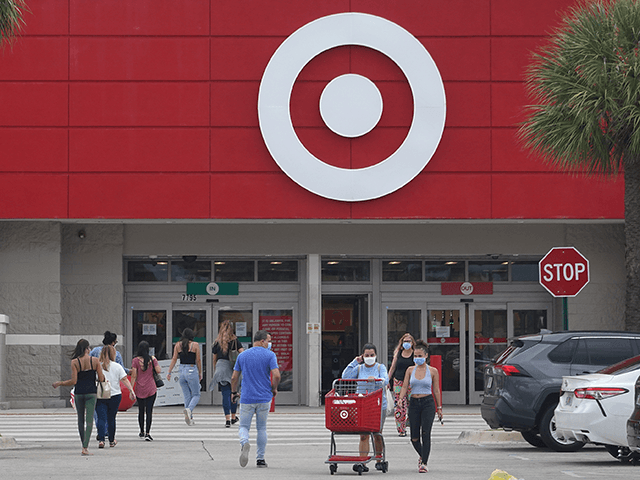Breitbart Business Digest: Americans Turn Even Gloomier About Biden’s Economy
The skies have grown darker over the American economy.
The Federal Reserve Bank of New York’s monthly survey of U.S. households indicates a dramatic turn for the worse in both current conditions and expectations for the year ahead. Thirteen percent of consumers say their household’s financial condition is “much worse” than it was a year ago, by far the worst ever score in data going back to 2013. That was 3.8 percentage points worse than just a month prior.
The share of consumers saying that things are “somewhat worse” jumped from 30.3 percent in April to 32.8 percent in May. This is also a record high for this figure. Combine both worsening categories and we get 45.8 percent of Americans viewing their financial conditions as worse than a year ago.
Let’s put this into historical context. On average prior to Joe Biden’s presidency, only 3.5 percent of people said they were much worse off than a year ago. The somewhat worse-off category included 18.7 percent, for a combined worsening of 22.18 percent. In other words, around twice as many people say they are worse off today than typically did before Biden became president. In case you are wondering, in April of 2020—the worst month of the pandemic and lockdowns, when the economy was nearly shut down—39.2 percent said they were worse off.

President Joe Biden (left) delivers remarks about the economy as Assistant to the President & Chair of the Council of Economic Advisers Cecilia Rouse (right) listens during an event in the Roosevelt Room of the White House on May 4, 2022. (Alex Wong/Getty Images)
Americans also turned gloomier about their near-term future. The share saying they expect to be much worse off a year from now rose to 10.8 percent from 6.6 percent, the worst ever score. The share saying they expect to be somewhat worse off rose to 28.6 percent from 25.3 percent, also a record. These combine for 39.4 percent saying they expect worsening conditions.
How does that compare with history? Dismally. The pre-Biden average—which includes the awful 2020—of those who said they expect to be much worse off was just 1.8 percent. The somewhat worse-off average was 14 percent. The combined average was 15.8. So again, the worse-off number is now twice what was typical.
Recall that on Friday, the University of Michigan’s survey of consumer sentiment showed that things were still getting worse as June rolled on. Its consumer sentiment index hit its worst level ever at 50.2, a 14 percent decline in a few weeks from an already depressed level. The reading of current conditions dropped 12.5 percent to 55.4, and the expectations gauge dropped by a steeper 15.2 percent to 46.8 percent.
This crash in consumer sentiment would support not only the view that we are headed for a recession but also that we’re already in a recession. In any event, we’re not far off. The economy contracted in the first quarter at a 1.5 percent rate. The Atlanta Fed’s GDPNOW gauge tells us that current economic data is indicative of growth of just 0.9 percent. A few more pieces of bad data and we’ll be right back in negative territory with just a few weeks left in the second quarter.
The dismal reads we got from so many of the regional Fed bank surveys of manufacturers—quite of few of which indicated either an outright contraction or nearly zero growth—also beckon toward recession. The S&P Global manufacturing purchase managers index, on the other hand, indicated that output continued to expand at a rate consistent with the ongoing expansion of the economy.
There are also these dismal earnings reports from Target, Walmart, and Costco and indications that some of the biggest retailers may have both too much inventory and too many employees. Big inventory overbuilds are a time-honored path into a recession in which production slows because businesses stop ordering new goods as they clear out unwanted inventory. Incidentally, this might help on the inflation side, since prices would fall due to discounting and sales to clear the warehouses. But stories of inventory overbuilds remain anecdotal. Data still shows no big surge in inventories this year—and so no reason for inventory contraction to help speed along a recession. That could change quickly, but it has not happened yet. In fact, if you look at real inventories—adjusting for the price of goods inflation—we are not yet at pre-pandemic levels across the economy.
Arguing against the idea that we’re already in a recession is robust consumer spending plans and ultra-low unemployment. The Fed survey showed that consumers plan to increase spending nine percent this year, higher than the median point prediction for inflation. So consumers are expecting not just enough spending to keep up with inflation but even more. That’s a story that supports the idea that the economy is growing in real terms and could keep growing, at least for the next few quarters.
This is the tension the Federal Reserve will be considering at the Federal Open Market Committee meeting this week. It’s likely that they will stick to the plan of a 50-basis point hike, although this is now seen as the minimum required. The futures-implied odds now give around a 30 percent chance of a 75-basis point hike, up from 3 percent a week ago. Steven Englander, global head of G-10 FX research at Standard Chartered Bank, thinks there’s a chance of a 100-basis point hike if the Fed wants to surprise the market in an attempt to get out from under the idea that it is “behind the curve.” More likely than a shock-and-awe hike—which does not seem to be Jerome Powell’s style—is a hawkish hike, where the Fed raises by the expected 50-basis point hike but hints at even bigger hikes to come.
The skies are dark. The hour is late. Unfortunately, there are likely darker times ahead.






Comments are closed.